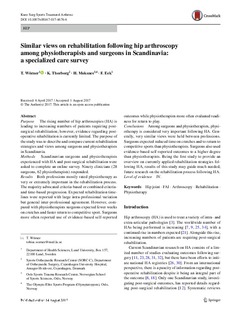| dc.contributor.author | Wörner, Tobias | |
| dc.contributor.author | Thorborg, Kristian | |
| dc.contributor.author | Moksnes, Håvard | |
| dc.contributor.author | Eek, Frida | |
| dc.date.accessioned | 2018-05-23T10:33:57Z | |
| dc.date.available | 2018-05-23T10:33:57Z | |
| dc.date.created | 2018-01-17T10:33:01Z | |
| dc.date.issued | 2017 | |
| dc.identifier.citation | Knee Surgery, Sports Traumatology, Arthroscopy. 2017, under utgivelse. doi:10.1007/s00167-017-4676-6 | nb_NO |
| dc.identifier.issn | 0942-2056 | |
| dc.identifier.uri | http://hdl.handle.net/11250/2498852 | |
| dc.description | This article is distributed under the terms of the Creative Commons Attribution 4.0 International License (http://creativecommons.org/licenses/by/4.0/), which permits unrestricted use, distribution, and reproduction in any medium, provided you give appropriate credit to the original author(s) and the source, provide a link to the Creative Commons license, and indicate if changes were made. | nb_NO |
| dc.description.abstract | Purpose: The rising number of hip arthroscopies (HA) is leading to increasing numbers of patients requiring postsurgical rehabilitation; however, evidence regarding postoperative rehabilitation is currently limited. The purpose of the study was to describe and compare current rehabilitation strategies and views among surgeons and physiotherapists in Scandinavia. Methods: Scandinavian surgeons and physiotherapists experienced with HA and post-surgical rehabilitation were asked to complete an online survey. Ninety clinicians (28 surgeons, 62 physiotherapists) responded. Results: Both professions mostly rated physiotherapy as very or extremely important in the rehabilitation process. The majority advocated criteria-based or combined criteriaand time-based progression. Expected rehabilitation timelines were reported with large intra-professional variation but general inter-professional agreement. However, compared with physiotherapists surgeons expected fewer weeks on crutches and faster return to competitive sport. Surgeons more often reported use of evidence-based self-reported outcomes while physiotherapists more often evaluated readiness for return to play. Conclusions: Among surgeons and physiotherapists, physiotherapy is considered very important following HA. Generally, very similar views were held between professions. Surgeons expected reduced time on crutches and to return to competitive sports than physiotherapists. Surgeons also used evidence-based self-reported outcomes to a higher degree than physiotherapists. Being the first study to provide an overview on currently applied rehabilitation strategies following HA, results of this study may guide much needed, future research on the rehabilitation process following HA. | nb_NO |
| dc.language.iso | eng | nb_NO |
| dc.subject | hip joint | nb_NO |
| dc.subject | FAI | nb_NO |
| dc.subject | arthroscopy | nb_NO |
| dc.subject | rehabilitation | nb_NO |
| dc.subject | physiotherapy | nb_NO |
| dc.title | Similar views on rehabilitation following hip arthroscopy among physiotherapists and surgeons in Scandinavia: A specialized care survey | nb_NO |
| dc.title.alternative | Similar views on rehabilitation following hip arthroscopy among physiotherapists and surgeons in Scandinavia: a specialized care survey | nb_NO |
| dc.type | Journal article | nb_NO |
| dc.type | Peer reviewed | nb_NO |
| dc.description.version | publishedVersion | nb_NO |
| dc.rights.holder | © The Author(s) 2017 | nb_NO |
| dc.source.pagenumber | 8 | nb_NO |
| dc.source.journal | Knee Surgery, Sports Traumatology, Arthroscopy | nb_NO |
| dc.identifier.doi | 10.1007/s00167-017-4676-6 | |
| dc.identifier.cristin | 1545023 | |
| dc.description.localcode | Seksjon for idrettsmedisinske fag / Department of Sport Medicine | nb_NO |
| cristin.unitcode | 150,34,0,0 | |
| cristin.unitname | Seksjon for idrettsmedisinske fag | |
| cristin.ispublished | true | |
| cristin.fulltext | original | |
| cristin.qualitycode | 1 | |
